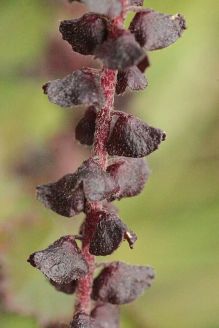Before the snow covers the ground and changes the landscape to true winter, covering up many of the remains of our wildflowers, we would like to highlight the amazing beauty found in winter “flowers”. Although one can still find an occasional intrepid flower head of Dandelion, Aster, or Goldenrod full of colorful blossoms, most actual flowers have long wilted by Thanksgiving. However, many of the fruits and seeds that now take the place of the flowers have a pleasing symmetry in shape and a flower-like quality, even if their color palette is limited to mostly white, silver, tan, and many shades of brown. Here are some examples we found around Hawthorne Valley over the last few days.
 This graceful structure stranded on the ice of the farm creek is the fruit of one of the many wind-dispersed species in the aster family. It is composed of a 1-seeded “achene” which carries an umbrella or “pappus” to help the seed fly through the air.
This graceful structure stranded on the ice of the farm creek is the fruit of one of the many wind-dispersed species in the aster family. It is composed of a 1-seeded “achene” which carries an umbrella or “pappus” to help the seed fly through the air.
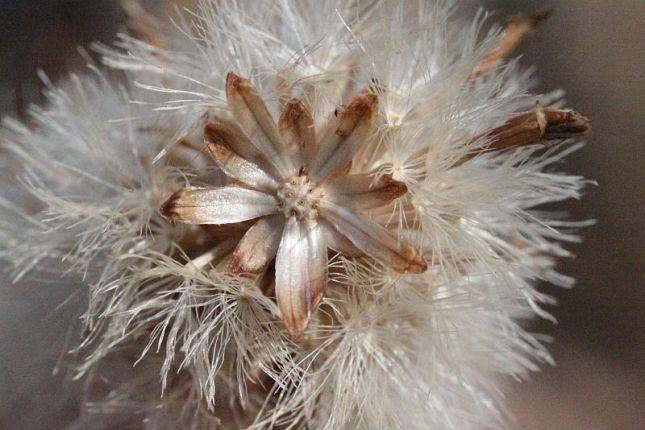 The wind-dispersed seeds of asters, goldenrods, Joe-Pye-Weed, and Boneset develop in flower heads, surrounded by a set of specialized leaves, the “bracts”, which often remain on the plant long after all the seeds have flown away and form a shape that looks like a silvery flower, itself. This picture shows a dense cluster of several flower heads, the center one having dropped all its seeds and displaying the flower-like structure composed of bracts. It is surrounded by the white umbrellas of seeds still attached to other flower heads. The brown structure on the right is a single withered, narrowly bell-shaped flower, still attached to the seed growing underneath it and surrounded by the seed’s “pappus”.
The wind-dispersed seeds of asters, goldenrods, Joe-Pye-Weed, and Boneset develop in flower heads, surrounded by a set of specialized leaves, the “bracts”, which often remain on the plant long after all the seeds have flown away and form a shape that looks like a silvery flower, itself. This picture shows a dense cluster of several flower heads, the center one having dropped all its seeds and displaying the flower-like structure composed of bracts. It is surrounded by the white umbrellas of seeds still attached to other flower heads. The brown structure on the right is a single withered, narrowly bell-shaped flower, still attached to the seed growing underneath it and surrounded by the seed’s “pappus”.
 The one-seeded fruits of Virgin’s Bower have feathery appendices that help them get carried away by the wind. They are arranged in clusters, each of which developed from a single white flower. Virgin’s Bower is a vine, whose fluffy fruit clusters can currently be seen draping over shrubs and tree branches in hedgerows and riparian areas.
The one-seeded fruits of Virgin’s Bower have feathery appendices that help them get carried away by the wind. They are arranged in clusters, each of which developed from a single white flower. Virgin’s Bower is a vine, whose fluffy fruit clusters can currently be seen draping over shrubs and tree branches in hedgerows and riparian areas.
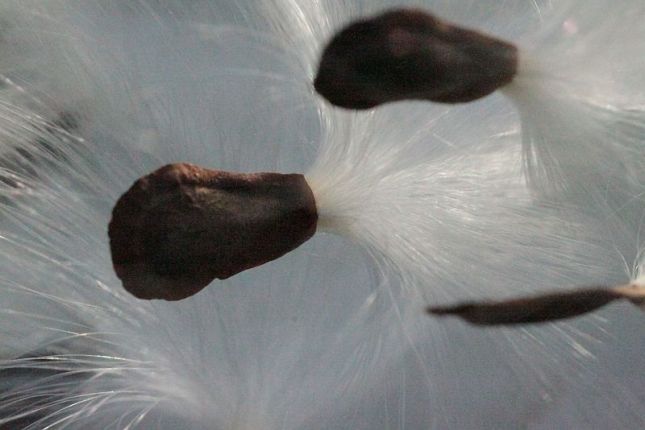 Milkweed seeds are another well-known example of wind dispersal.
Milkweed seeds are another well-known example of wind dispersal.
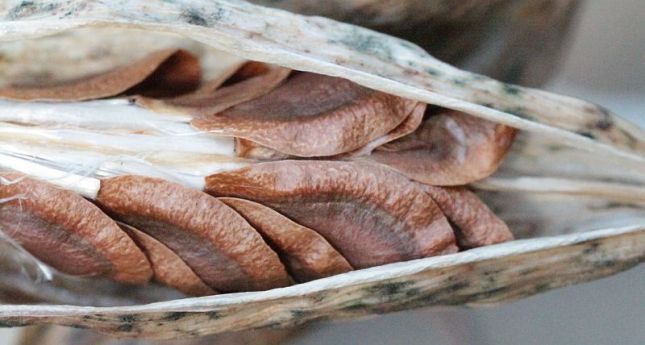 They grow tightly packed inside pods.
They grow tightly packed inside pods.
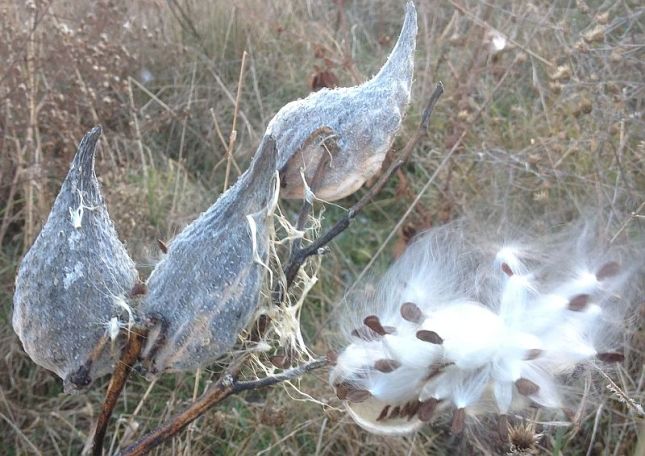 Once the pods open, the seeds are released into the wind, little by little…
Once the pods open, the seeds are released into the wind, little by little…
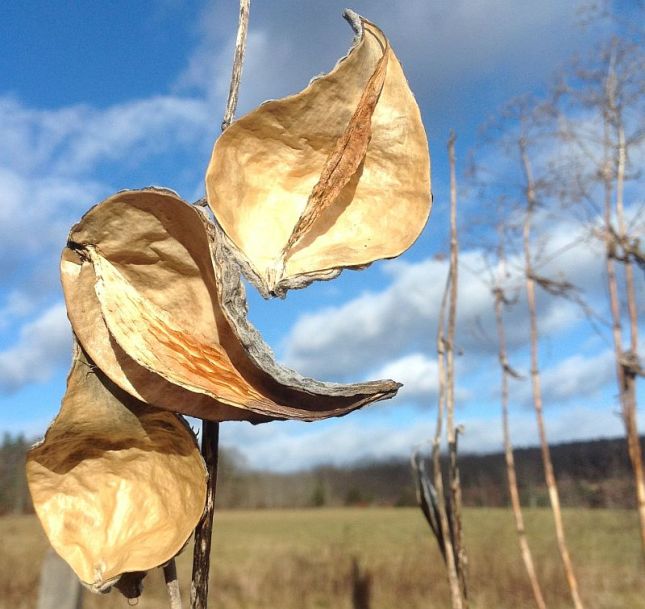 … until nothing else but the empty pod remains on the stalk.
… until nothing else but the empty pod remains on the stalk.
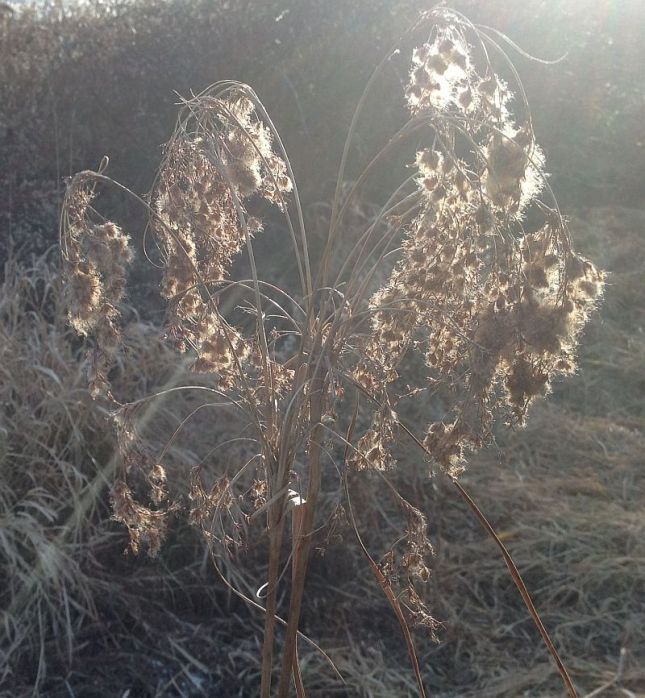 Woolgrass is only remotely related to true grasses. Its seeds are also wind-dispersed by means of “woolly” hairs.
Woolgrass is only remotely related to true grasses. Its seeds are also wind-dispersed by means of “woolly” hairs.
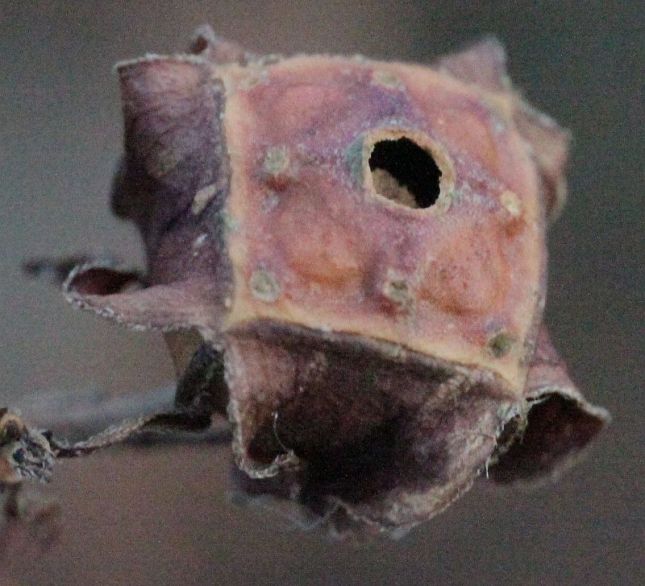 The fruits of Seedbox resemble little salt shakers who release their tiny seeds through a hole in the center, as the dried plant gets moved about in the wind or by passing creatures. Each fruit is less than 1/4 inch across. Note the flower-like pattern surrounding the central hole.
The fruits of Seedbox resemble little salt shakers who release their tiny seeds through a hole in the center, as the dried plant gets moved about in the wind or by passing creatures. Each fruit is less than 1/4 inch across. Note the flower-like pattern surrounding the central hole.
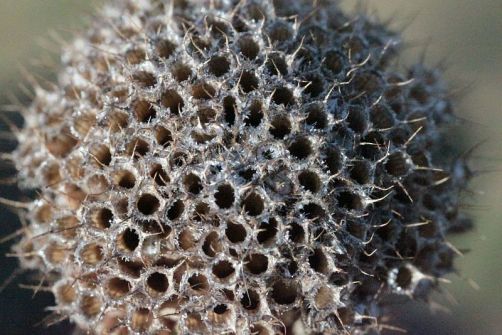 The flowers of Wild Bergamot grow in dense flower heads. The tightly packed calyxes persist far into the winter. Several little seeds have long since been released from the depth of each calyx cup.
The flowers of Wild Bergamot grow in dense flower heads. The tightly packed calyxes persist far into the winter. Several little seeds have long since been released from the depth of each calyx cup.
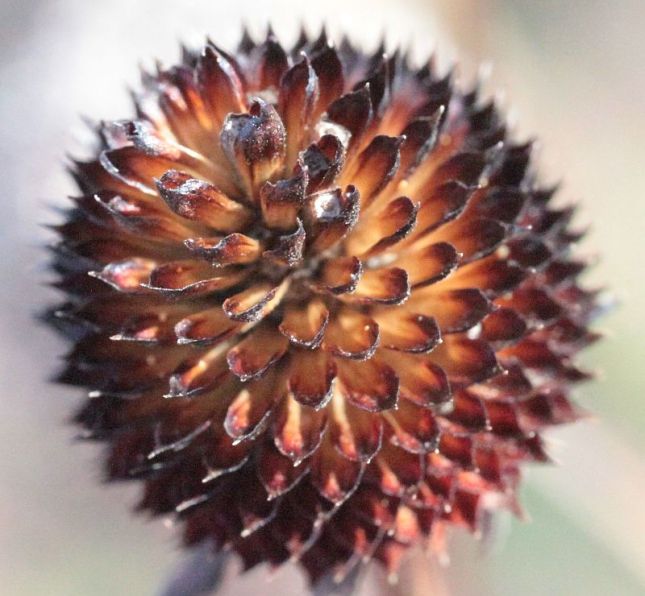 Brown-eyed Susan is a member of the aster family whose one-seeded fruits bear no umbrella. In this picture, a few fruits, held by their protective bracts, can still be seen at the center of the flower head.
Brown-eyed Susan is a member of the aster family whose one-seeded fruits bear no umbrella. In this picture, a few fruits, held by their protective bracts, can still be seen at the center of the flower head.
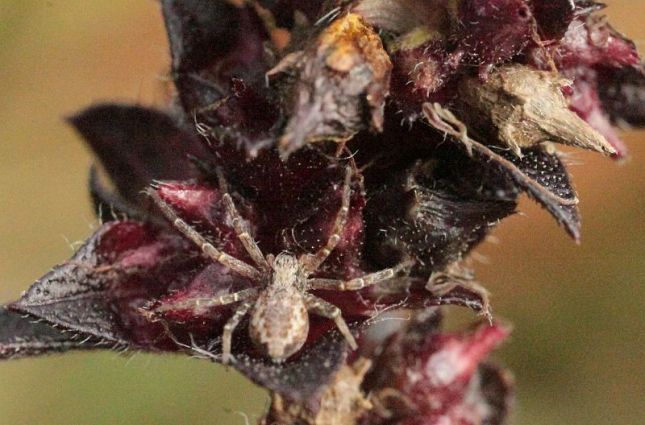 This little spider sits on a fruit of Common Ragweed. Note how the color of the spider makes it blend in perfectly against the fall coloration of the plant. Below are the remains of male flowers of the same plant, which in late summer released innumerable tiny pollen grains that are one of the main causes of seasonal allergies.
This little spider sits on a fruit of Common Ragweed. Note how the color of the spider makes it blend in perfectly against the fall coloration of the plant. Below are the remains of male flowers of the same plant, which in late summer released innumerable tiny pollen grains that are one of the main causes of seasonal allergies.
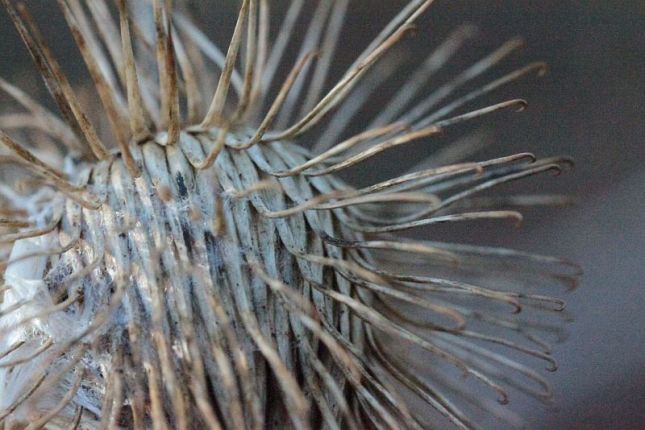 The seed heads of Common Burdock are the natural “velcro”. They are designed to get stuck in animal fur and to disperse as hitch-hikers. Have you ever got one of these stuck in your hair? No fun! But looked at closely, the burs (which are really the remnants of flower heads, with the mature seeds still hiding inside) have a certain visual esthetic about them.
The seed heads of Common Burdock are the natural “velcro”. They are designed to get stuck in animal fur and to disperse as hitch-hikers. Have you ever got one of these stuck in your hair? No fun! But looked at closely, the burs (which are really the remnants of flower heads, with the mature seeds still hiding inside) have a certain visual esthetic about them.
 These beautifully-sculpted fruits belong to Agrimony, a yellow-flowering member of the rose family which grows as a weed in pastures and hayfields. At this time of the year, it is a major source of little burs that get stuck on socks and other woolen garments. Obviously, this plant is also counting on animal dispersal for its seeds…
These beautifully-sculpted fruits belong to Agrimony, a yellow-flowering member of the rose family which grows as a weed in pastures and hayfields. At this time of the year, it is a major source of little burs that get stuck on socks and other woolen garments. Obviously, this plant is also counting on animal dispersal for its seeds…
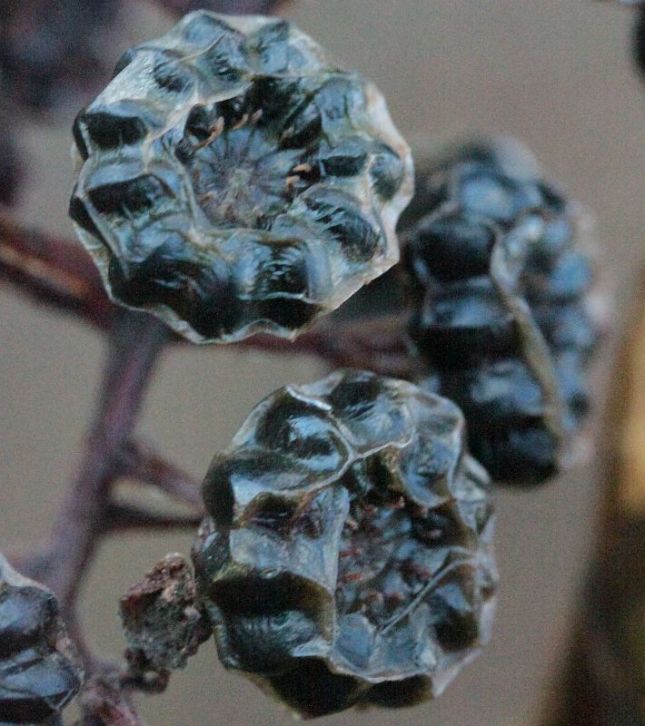 The plump and juicy deep purple fruits of American Pokeweed are getting dry, revealing the incredibly regular circular arrangement of seeds underneath the now transparent skin. Many parts of this plant, including the seeds, are poisonous to people!
The plump and juicy deep purple fruits of American Pokeweed are getting dry, revealing the incredibly regular circular arrangement of seeds underneath the now transparent skin. Many parts of this plant, including the seeds, are poisonous to people!
 Finally, here is a true late flower. It belongs to Witchhazel, a woody plant of the forest understory. Its delicate yellow flowers appear in October, just as the leaves turn yellow, and can often be seen alive and well into the winter. Below the flower are two open seed capsules which have ejected their seeds.
Finally, here is a true late flower. It belongs to Witchhazel, a woody plant of the forest understory. Its delicate yellow flowers appear in October, just as the leaves turn yellow, and can often be seen alive and well into the winter. Below the flower are two open seed capsules which have ejected their seeds.
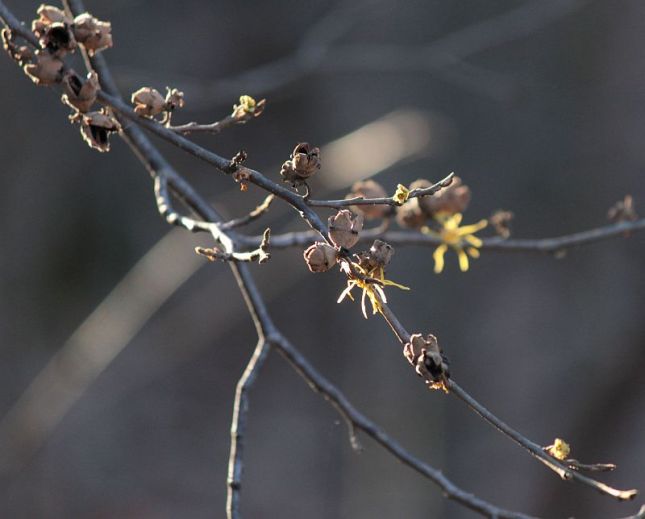 An entire Witchhazel branch with mixed this year’s flowers and fruits that have developed from the flowers that bloomed last fall.
An entire Witchhazel branch with mixed this year’s flowers and fruits that have developed from the flowers that bloomed last fall.
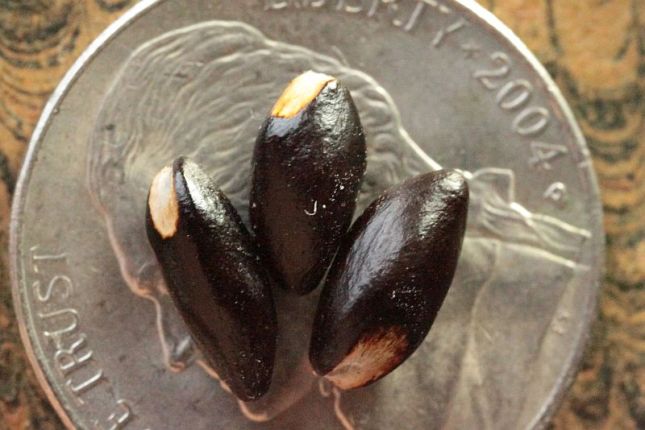 Try bringing home a few closed seed capsules and let them dry on the mantelpiece. As the capsules dry, they begin to open and shoot the seeds across the room. Alternatively, put them in a tin can and enjoy the “ping-ping-ping” as the seeds get released with great force.
Try bringing home a few closed seed capsules and let them dry on the mantelpiece. As the capsules dry, they begin to open and shoot the seeds across the room. Alternatively, put them in a tin can and enjoy the “ping-ping-ping” as the seeds get released with great force.

